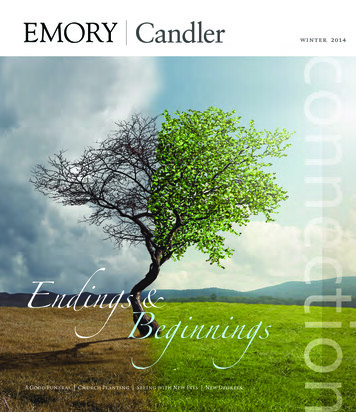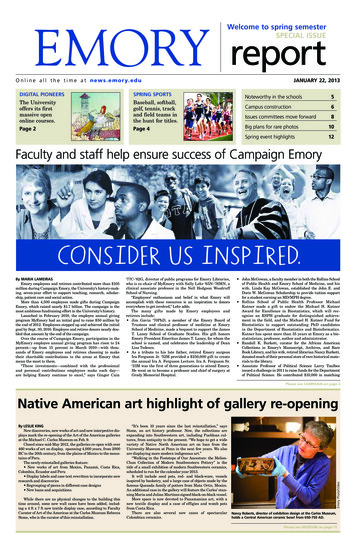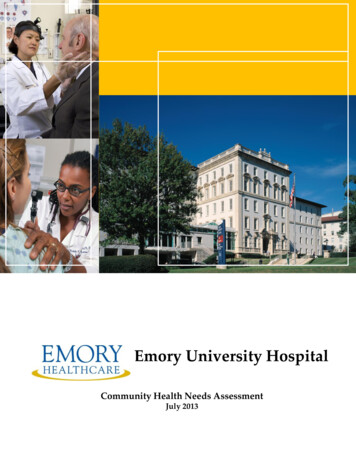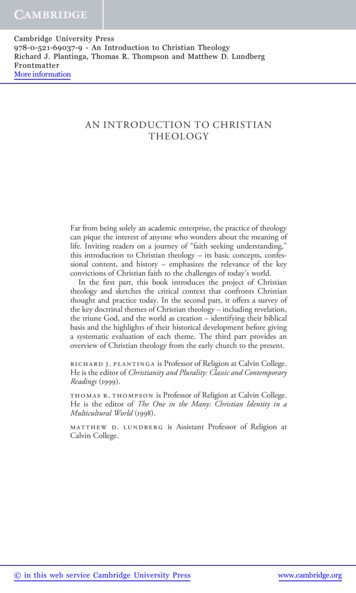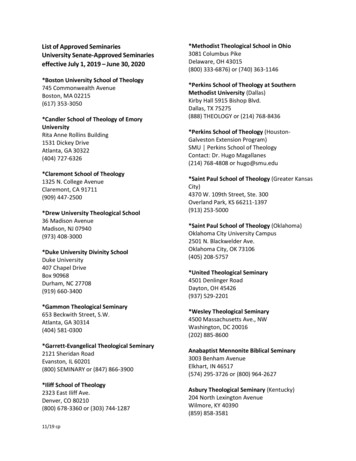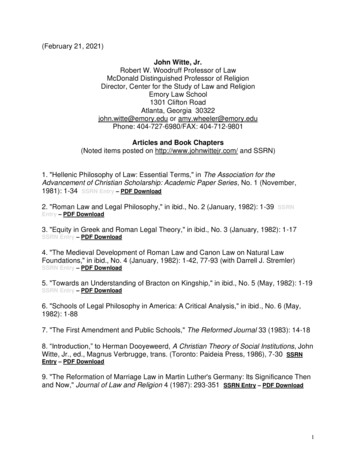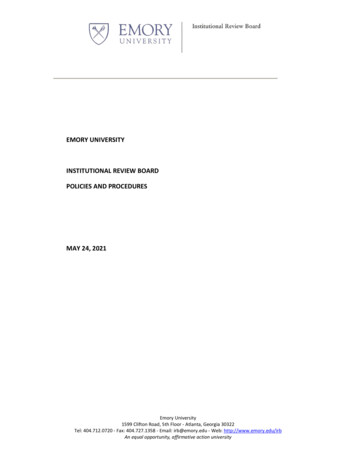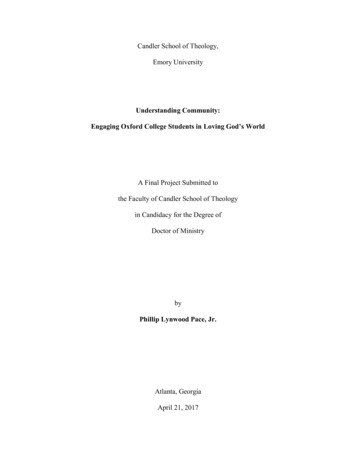
Transcription
Candler School of Theology,Emory UniversityUnderstanding Community:Engaging Oxford College Students in Loving God’s WorldA Final Project Submitted tothe Faculty of Candler School of Theologyin Candidacy for the Degree ofDoctor of MinistrybyPhillip Lynwood Pace, Jr.Atlanta, GeorgiaApril 21, 2017
Pace 2IntroductionThe relationship between local communities and colleges and universities has a longhistory referred to as town and gown relations. “Misunderstandings between these parties can betraced to historical developments and a lack of general understanding of the implications thatthese developments have on each other.”1 Oxford College (originally established as EmoryCollege and became Oxford College in the 1900s) and the city of Oxford, Georgia wereconcurrently planned by Georgia Methodists in 1836 and have since been engaged anddisengaged with one another throughout their existence. Today, the city and the college exist in agenial but apathetic relationship. The problem that motivates my project is this decline in therelationship between Oxford College and the local community of Oxford, Georgia. To addressthis, I designed a course to teach to first-and second- year students at Oxford College that wouldintentionally involve them in the immediate context of Oxford, Georgia, by creating relationshipswith local residents.This project is motivated by a demonstrated need to understand and see our communitiesmore deeply and to comprehend and embrace the transformation that comes when we belong andcreate structures of belonging in our lives. While, more broadly, this project is meant to be apractical offering for the church and the way the church relates to the world, more specifically inthe project itself, my interest is in the relationship between Oxford College and the city ofOxford, Georgia.2 While this project was developed to improve the ongoing town and gownrelationship between Oxford College and the city of Oxford, Georgia, more significantly, thegoal was for the students to be in the community and with the community, which is why aRoger L. Kemp, ed. Town and Gown Relations: A Handbook of Best Practices (Jefferson, North Carolina:McFarland & Company, Inc., 2013), 1.2When I refer to local residents from this point forward, I am referring to residents in Oxford, Georgia.1
Pace 3primary component of the class was interviews the students completed with local residents. Thisassignment was intended to create space for current students at Oxford College and localresidents in the city of Oxford to be present with one another in a way that normally does nothappen.3 It required them to listen to each other and learn from one another’s stories andexperiences in order to deepen their understanding of one another, which is why a uniquecomponent of the course involved starting each class with a contemplative practice. These fewminutes at the beginning of each class, informed by my own habits of prayer and contemplation,established a regular practice meant to enable them to achieve deeper awareness of themselvesand others. My responsibility as their chaplain is to open up the greater possibility for students tounderstand that their work in life is to not only be engaged with the world but in “loving theworld.”4The space created in the class for intentional interaction is born out of my theologicalconvictions about hospitality. The students in the class and the local residents were strangersliving in each other’s backyard. Except for a class like this, there would likely be no other timeor place where they would choose to meet. As a Christian minister whose vocation is to extendChrist’s love and justice in the world, with a particular focus in both my congregational setting atOxford College and the immediate locale of Oxford, Georgia, my task was clear: to offerhospitality by creating space for new relationships between students and local residents. Not thekind of hospitality that simply warms one’s heart or makes life more comfortable, but this wasabout seeking a hospitality that honors and moves across difference – a hospitality that LettyI use the word “with” throughout this paper intentionally. First, it is a word with theological significance in theChristian tradition. God is with us through the life, death, and resurrection of Jesus Christ. Jesus’ ministry was aboutbeing in relationship with people. Second, my goal in this course was to create opportunities for students to put theirbodies in the local community and in relationship with local residents.4“Loving the world,” is a phrase I will use throughout the paper, and it is taken from Mary Oliver’s poem,“Messenger.” Mary Oliver, Thirst: Poems by Mary Oliver (Boston: Beacon Press, 2006), 1.3
Pace 4Russell defines as “the practice of God’s welcome by reaching out across difference toparticipate in God’s actions bringing justice and healing in our world of crisis and fear of theones we call ‘other’.”5 In this kind of hospitality we are drawn out of ourselves to be with others,to put our bodies into places where we do not or even will not go so that we can see what hasbeen invisible to us – so as to resist the obliviousness that, according to Mary McClintockFulkerson, “characterizes far too much of North American society.”6 Hospitality such as thisguided the process of designing this course, inviting residents to participate, and then teaching itin the fall of 2016.My immediate audience is shaped by the academic context in which I have been engagedfor almost three years, the Doctor of Ministry degree program at Candler School of Theologyand my colleagues in it. As leaders in the church – local church pastors, administrative leaders,campus ministers, and chaplains – we have been on this journey together. I write with particularfaces and personalities in mind of those with whom I have been in ministry in order tocontextualize this project. A summation of my project will also be presented to this group at theend of our program in April 2017. The second audience is my professional context in ministry,Oxford College and its faculty, staff, and students as well as the local community of Oxford,Georgia. This audience was intimately involved in the project and will be addressed throughoutmuch of this paper. In the final portion of the paper I turn my attention to the church to offer thisproject and its findings as a model for the ways in which churches as well as college chaplainsand colleges engage their immediate communities.Letty M. Russell, Just Hospitality: God’s Welcome in a World of Difference, eds. J. Shannon Clarkson and KateM. Ott (Louisville: Westminster John Knox Press, 2009), 31.6Mary McClintock Fulkerson, Places of Redemption: Theology for a Worldly Church (New York: OxfordUniversity Press, 2007), 18.5
Pace 5Exploring the ProblemThe problem that motivates my project is the decline in the relationship between OxfordCollege and the local community. Students at Oxford College are able to complete their two-yearexperience without any engagement in the local community. This problem is informed by thedecline in the civic engagement among everyday citizens and residents in the United States. It isalso influenced by the ways in which colleges and universities in the United States havechanged.7 Combine this with the fact that churches are often insular communities that neglecttheir local community and have all too often contributed to the decline in civic and communityengagement, and there is an ecclesiological problem. Ultimately, this is a theological problem,because knowing our neighbor(s) has become almost impossible, thus preventing us from beingwith our neighbor. God came to be with humanity in Jesus, and Jesus taught those who wouldlisten that love of God and love of neighbor were central in his Jewish faith. For Christians, ithas become the law by which we are to live.Though this project focuses on students at Oxford College and local residents in the cityof Oxford, Georgia, the results of the project can also be applied to the life of our local churchesand the communities in which they are situated. Just as the students at Oxford College and thelocal residents of Oxford, Georgia lead multi-faceted lives that are busy and sometimes chaotic,so do the people in our local churches and their surrounding community. We all worship avariety of gods. James K. A. Smith refers to this as the rival liturgies in our lives.8 Waking up tothe rival liturgies of our lives means that we create a church of “graced community” that haslearned to embody “bounded openness,” a church “where people experience the glory and prideI will speak to this with regards to my setting of Oxford College under the heading “Initial Research” below.James K. A. Smith, You Are What You Love: The Spiritual Power of Habit (Grand Rapids: Brazos Press, 2016),23.78
Pace 6of being adorned by God and the humility and gratitude of being judged and forgiven by God.”9This “bounded openness” is what Serene Jones talks about in Feminist Theory and ChristianTheology where she writes about her church in a tone that is strikingly familiar to me as I thinkabout a college where Christianity was once central to its existence. “We are a gathering ofrather marginal people who belong to a now marginal institution, which because of its history,sits at the center of the city – and the world whirls around and through it.”10 The church ofbounded openness is one that has boundaries that are continually undone by the word of God thatbreaks in upon it. It is a church that is deeply vulnerable to the sin of the world, which means it isa church that even more deeply knows it too is so often part of a sinful system of oppression.11This church where glory and pride, humility and gratitude are part of the lived experience is onethat requires its people to pay attention to their own lives, the lives of others and the world, andmost especially the life of the local community in which it is situated. The image of boundedopenness lets us see, even if briefly, the principal features of Christian community. This kind ofchurch and its clergy will structure places of belonging to ensure its people not only sharerelationships with one another and are responsible for one another inside the church but evenmore so beyond the church itself and into the local community. It is a kind of church wherepower is shared not only among the people inside the church but also with the communitymembers in the church’s immediate locale.I am an ordained clergy member appointed to serve as an extension minister in the UnitedMethodist Church at Oxford College of Emory University, a two-year liberal arts college locatedon Emory’s historic original campus. Students may choose to start their four year EmorySerene Jones, Feminist Theory and Christian Theology: Cartographies of Grace, Guides To Theological Inquiry,eds. Kathryn Tanner and Paul Lakeland (Minneapolis: Fortress Press, 2000), 175.10Ibid, 169.11Ibid, 172.9
Pace 7undergraduate experience on the Druid Hills campus of Emory or at Oxford College. Thecollege’s demographics look quite a bit different today than they did at its founding or eventhirty years ago. Eighteen percent of the student body at Oxford College are internationalstudents. Women compose sixty percent of the student body, and the combination of studentstraditionally identified as racial/ethnic minority students far outnumber the students traditionallyidentified as racial/ethnic majority students. 12 There are ten religious and spiritual life clubs oncampus representing Buddhism, Christianity, Hinduism, Islam, and Judaism. We have more selfidentified Muslim students at Oxford College than Methodist students.13 Though the studentpopulation looks different than it has for any previous college chaplain, ministry remains vitallyimportant. My vocation as a college chaplain involves ministry with faculty, staff, and students,all part of my ministerial appointment, and it also involves ministry with the local community. Ifserving in a local church, I would understand my ministry in a similar way, as being both to themembers of the congregation as well as to those who live in the immediate location in which thechurch is situated.The college and the city, both founded by leaders in the church, grew up together.“Emory’s founders had heard themselves addressed by a gospel promise that the truth would setthem free, and therefore freedom, democracy, education, and religious faith all relied on eachother to some extent.”14 They practiced their own ecclesiology and viewed the church’s missionas being in relationship with the world. For them, this relationship was embodied in education. Inthe words of the University’s charter, “Designed to be a profoundly religious institution withoutbeing narrowly sectarian,” Emory proposed “to encourage freedom of thought as liberal as theOffice of Undergraduate Admission, “Fast Facts: Admission Profile, Oxford College,” Emory University,accessed February 27, 2017, is data can only be accessed by those with permission at www.opus.emory.edu.14Gary Hauk, A Legacy of Heart and Mind: Emory Since 1836 (Atlanta: Emory University, 1999), xvi.12
Pace 8limitations of truth.”15 Education had the potential to transform people, indeed the culture, andGeorgia Methodists saw that as part of the church’s mission. These early church leaders inOxford, Georgia, allowed their religious faith to help them engage and shape society. It istherefore worth acknowledging that the relationship between the college and the city, especiallybetween residents and students, has waned over time.This diminished relationship is not surprising. Civic engagement among individuals andin local communities in the United States has been trending downward for decades. As he pointsout in his monumental research on the subject, Robert Putnam suggests that social capital inalmost all its forms increased substantially between 1947 and 1965 and decreased substantiallybetween 1965 and 1998.16 And while he and Thomas H. Sander suggest in a subsequent 2010article that Americans are engaging differently, they claim there is no convincing evidence thatAmericans are becoming more civically engaged.17 America, as described by Alexis deTocqueville in Democracy in America, has always relied on its public and voluntary associationsto build its civic and communal life. Tocqueville writes in the early 1800s, “In America I haveencountered several types of associations of which I confess I had no notion and I havefrequently admired the endless skill with which the inhabitants of the United States manage toset a common aim to the efforts of a great number of men and to persuade them to pursue itvoluntarily.”18 But it is these voluntary associations that are in a state of constant decline asPutnam and other social capital theorists point out. Although Harvard sociologist and politicalscientist Theda Skocpol suggests that we cannot go back to the civic world we have lost, sheIbid, xvi.Robert Putnam, Bowling Alone: The Collapse and Revival of American Community (New York: Simon &Schuster Paperbacks, 2000), 281.17Thomas H. Sander and Robert Putnam, “Still Bowling Alone?: The Post-9/11 Split,” Journal of Democracy 21,no. 1 (January 2010): 14.18Alexis De Tocqueville, Democracy in America and Two Essays on America, trans. Gerald E. Bevan (London:Penguin Books, 2003), 596.1516
Pace 9(and others) push us forward to new forms of connection and building associations, especially ifwe want to renew our democracy.19 They remind us that civic involvement is becoming more ajob in today’s America and less a citizen’s responsibility.Social LocationBefore delving into my initial research for this project, it is important to identify my ownsocial location. To be able to see ourselves and to wake up to our own power and privilege iscritical to any research but especially research that addresses how God shapes our communallives. As a white, heterosexual, cisgender, Christian, temporarily able-bodied, and middle-classmale, historically others like me have shaped the dominant narratives in our communities overtime and still do so today. I have enjoyed my own exercise of privilege and power, albeit oftenunbeknownst to me at the time, but nevertheless revealed to me later. As a United Methodistminister whose ministry context is a chaplain at a college, my appointment to this position is asan extension minister, meaning that I am “appointed to serve in a ministry setting beyond thelocal United Methodist Church in the witness and service of Christ’s love and justice.”20Remembering and honoring my place in the United Methodist Church is important throughoutthis project, because it is not only the college I am interested in connecting to the world (andspecifically our local community) but also the church, of which the United Methodist Church isone denomination.My research has, in a modest way, drawn from ethnography, which “is a way ofimmersing yourself in the life of a people in order to learn something about and from them.”21 AsTheda Skocpol, Diminished Democracy: From Membership to Management in American Civil Life (Oklahoma:The University of Oklahoma Press, Norman, 2003), 292.20L. Fitzgerald Reist, ed., et al., The Book of Discipline of the United Methodist Church 2008 (Nashville: TheUnited Methodist Publishing House, 2008), 254.21Mary Clark Moschella, Ethnography as a Pastoral Practice: An Introduction (Cleveland: The Pilgrim Press,2008), 4.19
Pace 10a pastoral practice, ethnography helps us to open our eyes and ears in order to pay attention toand understand the ways in which people practice their faith.22 This work has involved bothOxford College students and local residents, and in my project I sought to bring those two groupstogether. A key component of ethnographic research and the work done with students and localresidents is reflexivity. The process of reflexivity is one that requires constant self-study. AsMary Clark Moschella notes, “ethnographers know that in order to study a group of people, theymust also study themselves. Such self-study is termed ‘reflexivity’.”23 To aid in my own practiceof reflexivity, I have engaged in individualized ways of reflection through the incorporation ofcontemplative practices including prayer, music, silence, walking meditations, and poetry.Communal practices such as sharing meals with neighbors and strangers, Christian worship, anda weekly running group have been essential. These practices help me achieve a greater sense ofstillness and balance in my life, which in turn allows me to focus more deeply on mycongregants, especially students and local residents.Initial ResearchThe initial research for this project resulted in at least three key findings. First, it renewedmy own personal commitment to understanding, engaging, and transforming community. Thisrevealed a deeper sense of vocational responsibility and commitment as a college chaplain. Morethan that, though, it was essential to be a part of finding and creating structures of belonging incommunities, places that encourage and strengthen our interdependence as much as and evenmore than our independence.24 Early on, my research allowed me to see the community thatsurrounds my ministry context, reminding me of how the Anglican priest John Wesley saw theIbid, 4.Ibid, 31.24This sentence and much of my work in this project is influenced by Peter Block, Community: The Structure ofBelonging (San Francisco: Berrett-Koehler Publishers, Inc., 2008).2223
Pace 11world as his parish and thus inspired a movement with the people called Methodists. I was alsoinformed by the ways in which Jesus paid attention to the communities where he lived and thepeople with whom he was in ministry as evidenced by those who were often invisible to othersbut with whom he talked, ate, revealed, and cast out demons. God was already at work in myministry context and the local community, if only I had the eyes to see and ears to hear God’sspirit moving. By opening my eyes and ears and putting my body into the community in waysthat encouraged and challenged me along this journey, I learned that there is a gap in ways ofbelonging for both students and local residents.Secondly, this research led to the discovery from the college’s volunteer programs staffmember that Oxford students have spent most of their off-campus volunteer efforts (close to15,000 hours per year) in activities partnered with non-profits in cities other than Oxford.25 Forthe most part, students’ work in off-campus volunteer efforts was built on a service systemmodel that, according to community organizer John McKnight, emphasizes people’sdeficiencies.26 Students were “helping” and “serving” others but not analyzing larger systems ofinjustice, history of the place, and the local residents. They were doing work for people but werenot necessarily being with people. So not only was the narrative of the city of Oxford, itsresidents, and potential connections being missed because of where the students’ work was beingdone, but the kind of work they were so often doing relied on traditional forms of servicedelivery that maintained a dependency on professionals. For instance, in order to participate inthe Theory Practice Service Learning (TPSL) program at the college, a faculty member has to beable to find a non-profit organization with which to partner so that the students’ work can beverified. Because the city of Oxford does not have enough non-profits to handle the service hours2526Kasey J. Robinson, interview by author, recorded in notes, Oxford, Georgia, November 10, 2014.John McKnight, “Why ‘Servanthood’ Is Bad,” The Other Side, January/February 1989, 39.
Pace 12students are required to earn in this program, faculty tend to partner outside of Oxford. They alsotend to collaborate with traditional non-profits that are often doing good work but focus in a“services” only capacity. McKnight argues that the traditional model of delivery of socialservices to “needy individual clients” tends to allocate most of its money to professionals andmore importantly it “displaces the capacity of people’s organizations to solve problems.” 27 Itfocuses more on professional service systems and less on community, leaving the question,“What about relationships and responsibility in those relationships?”In this same vein, no one was organizing members of the local community in ways thatled them to interactions with the campus community, most especially students. As Kathleen J.Greider notes, “the persons, families, and communities practical theologians seek to serve haveidentities that are religiously multifaceted, and the webs of connection in which they interact areweighted by histories, futures, meanings, commitments, joys, and suffering shaped by religiousmultiplicity.”28 Many of the residents in the immediate surrounding locale have limitedexperience with a number of the religious traditions represented in our student body. This wasanother reason to create a project that would intentionally partner Oxford students and localresidents. While there are many benefits from the interaction of students and local residents, oneoverarching benefit to the college is the possibility of a stronger relationship to its communitythat could lead to fewer misunderstandings, misconceptions, and assumptions for all partiesinvolved. More than this, though, is the benefit students gain from the intentionality of puttingtheir bodies into relationship with a new place and people they would have never met. Thiswould give them the opportunity to see and feel the ways in which their bodies react to theirIbid, 39-40.Kathleen J. Greider, “Religious Pluralism and Christian-Centrism” in The Wiley Blackwell Companion toPractical Theology, ed. Bonnie J. Miller-McLemore (Oxford: Wiley Blackwell, 2014), Pg. 452.2728
Pace 13neighbors. Knowing how we physically react in these experiences with our neighbors can beinformative and transformative for future interactions in our communities. This knowledgeincreases the opportunity for us to engage in the work of loving the world.Finally, through my research, interviews, and personal engagement in the life of thecommunity of Oxford in the 2014-2015 academic year, I found that the connection between thecollege and the city had diminished over time. The local residents of Oxford and the students atOxford College seemed to have a decreased sense of belonging to one another, especially interms of how Peter Block describes it: “Our communities are separated into silos; they are acollection of institutions and programs operating near one another but not overlapping ortouching.”29 In this research, many of the local residents indicated that they felt a lack ofengagement with Oxford College. They also desired a relationship with students.In the spring of 2015, I selected people to participate in a “mapping team” that consistedof members of the college community and local residents who would have the opportunity tomeet with one another four or five times over the course of two to three months. We gathered ina variety of places both on the college campus and in the community, and always had snacks andbeverages. Members included faculty, staff, and students from the college and an equal numberof local residents from the community representing a diversity of race, age, and gender. At thesemeetings, members of the mapping team had the opportunity to tell their own life story, shareabout the gifts they bring to their community, and also talk about their experiences in Oxford. Inone case there was a faculty member who also lives in the city of Oxford as a member of themapping team demonstrating some overlap between the college and the city. Mapping teammember and older resident Jane Young talked about how she would like to see new ways in29Peter Block, Community, 5.
Pace 14which the students and residents (especially “older and lonelier” residents) could interact.30 Shenoted that in previous periods of history the connection felt stronger and that people in the localcommunity really do yearn to know the students today.31In my research over the course of the 2015-2016 academic year, another motivatingfactor for this project emerged from the idea that “we are what we love.” This notion is heavilyinfluenced by the work of James K. A. Smith who focuses on the habits we engage in our life.He is dedicated to helping us uncover the desires of our heart, the ways in which we engage theworld unconsciously and subscribe to rival liturgies in our lives. Smith argues that we are whatwe love, which means that our habits form and reform us. He says that “we need to recognizethat there are rival liturgies everywhere. These pedagogies of desire are, in a sense, culturalliturgies, rival modes of worship.”32 To become aware, conscious of what we are participating inrather than simply operating on auto-pilot is essential. This is true of those of us in the church,business world, as parents, and yes, in college.It is especially true as we think of our relationship to and participation in our localcommunities. It helped me focus on the communities where I live, work, and with whom I wasengaged in this project, Oxford College and the city of Oxford. When we recognize the power ofhabit in our lives and wake up to the rival liturgies in which we are participating, then we realizewe are more than thinking beings. This was an important realization, especially whenconsidering the work of a chaplain with college students who are asked to be thinking beings butso rarely asked to also be beings who think and feel with their bodies and not just their heads.My goal in this project became clearer, for students to see beyond their classroom experience andThe name in this sentence and subsequent footnote has been changed to keep the statement confidential.Jane Young, interview by author, recorded in notes, Oxford, Georgia, April 7, 2015.32James K. A. Smith, You Are What You Love, 23.3031
Pace 15put their bodies into the community of Oxford in a way that was not currently happening. Puttingbodies into communities to physically interact with neighbors whom we would not otherwisemeet allows us to do more than get to know our neighbors. We know our bodies and theirreactions better. We become conscious of our power and privilege through our bodies and theirinteractions with our neighbors. Smith says, “ we need to embrace a more holistic, biblicalmodel of human persons that situates our thinking and knowing in relation to other, morefundamental aspects of the human person.”33 How could students know this community ofOxford and its people? What could be done through this project to help them not only know thecommunity but be present in and with the community? How might this lead to them loving theworld in which they live and move and have their own being?Addressing the ProblemThe design of the course Understanding Community: Oxford Encountering Oxford beganin the summer of 2015 as a way to institutionalize the kind of relationships I was hoping toenable and embolden between Oxford College students and the local residents. My primaryaudience at the college has always been students, because they are my congregation, and I seemyself as their pastor. Colleges and universities do not exist without the students. Truth be told,the city of Oxford, Georgia, would likely not exist were it not for its relationship to OxfordCollege. Also, based on anecdotal evidence, students were always the subject of conversationswith local community members when talking about the relationship (or lack thereof) between thecollege and local community. Stephen M. Gavazzi says that students are the most important partof the relationship between campus and community not only because they are the reasonuniversities exist, but also because they are sent by families and communities
Candler School of Theology, Emory University . Understanding Community: Engaging Oxford College Students in Loving God's World . A Final Project Submitted to . the Faculty of Candler School of Theology . in Candidacy for the Degree of . Doctor of Ministry . by . Phillip Lynwood Pace, Jr. Atlanta, Georgia . April 21, 2017
